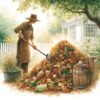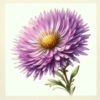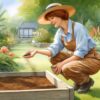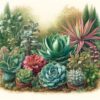Introduction
Welcome to the enchanting and colorful world of wildflowers! These resilient and vibrant plants are more than just a visual delight. They are an integral part of our ecosystems, offering a variety of benefits to our environment. This guide aims to enlighten you about wildflowers, their regional characteristics, popular types, and provide practical tips for starting your own wildflower meadow. Whether you’re an avid gardener or a nature enthusiast, this journey into the world of wildflowers is sure to captivate and inspire you.
What is a Wildflower?
wildflower
or wild flow·er
[ wahyld-flou-er ]
noun
- the flower of a plant that normally grows in fields, forests, etc., without deliberate cultivation.
- the plant itself. (from dictionary.com)
Wildflowers are nature’s spontaneous bursts of color. Often misunderstood as just any wild plant, wildflowers have unique characteristics that set them apart. In this section, we’ll explore what defines a wildflower and how they differ from other plants, shedding light on their importance in our natural world.
Definition Wildflower
Wildflowers are plants that grow in the wild without intentional seeding or planting. Unlike cultivated flowers, they are native to their specific regions and have adapted to their local environment over time. These resilient plants add diversity to our landscapes and provide essential habitats for wildlife.
Regional Variations of Wildflowers
Like a painter’s palette, wildflowers vary dramatically across different landscapes. Each region boasts its unique flora, shaped by climate, geography, and local ecosystems. This section highlights how wildflowers are a reflection of their regional environments, emphasizing the importance of understanding these variations for both appreciation and cultivation.
Wildflowers are incredibly diverse and their presence varies depending on the region. For example, the Bluebonnet is iconic in Texas, while California boasts the vibrant California Poppy. Each region has its unique set of wildflowers that have adapted to local climates and soil conditions. Understanding these regional differences is key to appreciating and growing wildflowers in your area.
Most Popular Wildflowers
Among the vast diversity of wildflowers, some have captured hearts and imaginations more than others. Here, we list some of the most beloved and iconic wildflowers. These plants are not only popular for their beauty but also for their adaptability and resilience in various environments.
- Sunflower (Helianthus)
- Bluebonnet (Lupinus texensis)
- California Poppy (Eschscholzia californica)
- Black-Eyed Susan (Rudbeckia hirta)
- Purple Coneflower (Echinacea purpurea)
These are just a few examples of the countless varieties of wildflowers found across different regions.
Creating Your Own Wildflower Meadow
Imagine a canvas of vibrant colors and textures right in your backyard. Creating a wildflower meadow is a fulfilling project that brings nature closer to home. This section offers a step-by-step guide to starting your wildflower haven, from selecting the right location to sowing the seeds of your chosen blooms.
Starting a wildflower meadow is a delightful project. Here’s how to begin:
- Choose the right location: Pick a spot that gets plenty of sunlight.
- Prepare the soil: Clear the area of existing vegetation and ensure the soil is well-drained.
- Select regional wildflower seeds: Opt for native species to ensure better growth and sustainability.
- Sow the seeds: Scatter the seeds evenly and lightly rake them into the soil.
- Water and maintain: Keep the soil moist until the seeds germinate, then water as needed.
Tips for Success
While wildflowers are known for their hardiness, they do require some care and knowledge to flourish. This section provides essential tips and tricks to ensure the success of your wildflower meadow. Learn how to nurture these natural beauties and create a thriving, sustainable habitat for local wildlife.
- Be patient: Wildflowers can take time to establish and bloom.
- Avoid fertilizers: Wildflowers thrive in nutrient-poor soils.
- Embrace variety: A mix of species will provide a more resilient and vibrant meadow.
- Support wildlife: Consider planting varieties that attract bees, butterflies, and other pollinators.
Educational Resources
To delve deeper into the world of wildflowers and obtain region-specific information, there are numerous educational resources available. In this section, find links to .edu sites and other authoritative sources. These resources offer valuable insights and detailed information to help you in your wildflower journey, whether for academic, gardening, or conservation purposes.
For more detailed information and guidance specific to your region, here are some excellent .edu resources:
- Lady Bird Johnson Wildflower Center
- USDA PLANTS Database
- Native Plant Society of your state or region
Embark on this wildflower adventure and uncover the secrets and splendors of these natural wonders. With the right knowledge and a bit of care, you can transform any space into a dazzling display of nature’s beauty. Happy wildflower gardening!
Wildflower FAQ: Your Questions Answered
1. What exactly are wildflowers? Wildflowers are plants that grow naturally in the wild without intentional human cultivation. They are typically native to the region in which they grow and have adapted to local environmental conditions.
2. Can wildflowers grow in any type of soil? While wildflowers are adaptable, their growth can vary depending on soil type. Most prefer well-drained soil, but some species thrive in specific conditions like sandy or clay soils.
3. How do I start a wildflower garden? To start a wildflower garden, choose a sunny location, prepare the soil by removing existing vegetation, select native wildflower seeds, scatter the seeds evenly, and keep the soil moist until germination.
4. When is the best time to plant wildflower seeds? The best time to plant wildflower seeds varies by region, but generally, they can be sown in spring or fall. In cooler climates, spring planting after the last frost is ideal, while in warmer regions, fall planting can yield good results.
5. How long does it take for wildflowers to bloom? The blooming time for wildflowers varies widely among species. Some may bloom within a few months after planting, while others might take a year or more to establish themselves and bloom.
6. Do wildflowers require a lot of maintenance? Wildflowers are generally low maintenance. They don’t require fertilizers and need minimal watering once established. However, some weeding and control of invasive species may be necessary.
7. Are wildflowers beneficial to the environment? Yes, wildflowers are highly beneficial to the environment. They support biodiversity by providing habitat and food for pollinators like bees, butterflies, and birds.
8. Can I grow wildflowers in pots or containers? Yes, many wildflowers can be grown in pots or containers, provided they have enough soil depth and are placed in a location that receives adequate sunlight.
9. How do I choose the right wildflowers for my region? Research native species in your area or consult local gardening centers or .edu websites for information on regional wildflowers. Choosing native plants ensures better growth and ecological support.
10. Are wildflowers affected by pests or diseases? Wildflowers, like all plants, can be susceptible to pests and diseases. However, their native resilience often means they are less affected than non-native species. Regular monitoring and environmentally friendly pest control methods can help manage any issues.










